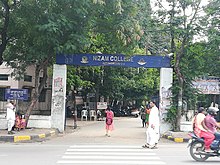Aghorenath Chattopadhyay
Aghorenath Chattopadhyay | |
|---|---|
 | |
| Born | 31 October 1851 |
| Died | 28 January 1915 (aged 63) Calcutta, Bengal, British India |
| Spouse | Varada Sundari Devi |
| Children | 8, including Sarojini, Virendranath Harindranath; Suhasini |
Aghorenath (also spelt Aghornath) Chattopadhyay (1851–1915) was an Indian educationist and social reformer.[1] First Indian to secure a D.Sc. (Doctor of Science) degree, he later became the first principal of Nizam College, Hyderabad.[2] The renowned poet and Indian political activist Sarojini Naidu was his eldest daughter.
Biography
Early years
Aghorenath was born in Bhrahmongaon in Kanaksar Village Bikrampur (then in Bengal Presidency now in Bangladesh). After completing his initial education in Dhaka Collegiate School, he spent three and a half years in Presidency College, Kolkata before moving to University of Edinburgh on Gilchrist Scholarship for higher studies.[3] He excelled in his studies and secured the Hope Prize and Baxter Scholarship.[4][5]
Career and Politics

Upon his return to India, he accepted the invitation from Nizam of Hyderabad State to modernise the education system there. He began with an English medium school. With Nizam's support he founded the Hyderabad College with himself its first principal which later became the Nizam College. Later he also initiated efforts to start a College for Women as a part of Osmania University. He was instrumental in implementing the Special Marriage Act 1872 in the Hyderabad State, which was already in vogue in British India. Aghorenath was a prominent member of the intellectuals' collective of Hyderabad who debated on social political and literary topics. Around this time Aghorenath also got involved in politics.[6]
He had differences of opinion with the Nizam on the Chanda Rail Project and a displeased Nizam suspended him from his job and deported him out of Hyderabad on 20 May 1883.[7][8] However a few years later he was recalled and reinstated. In fact it was Nizam who later provided a scholarship for Sarojini to pursue her studies in England.[9]
Back in Hyderabad Aghorenath continued his political activism and hence was forced to retire early and relocate to Kolkata. He and his wife Varada Sundari Devi set up residence at Lovelock Street, Kolkata.[citation needed]
Personal life

Aghorenath was married to Varada Sundari Devi before he left for Edinburgh. During his absence Varada Sundari was an inmate at the Bharat Ashram, an educational centre run by Keshab Chandra Sen. She accompanied him to Hyderabad in 1878. The couple had 8 children four girls and four boys. Sarojini was the eldest. Sarojini Naidu describes her father as a dreamer and an intellectual with unending curiosity. It was this curiosity that turned him into an alchemist in search of a recipe for gold.[10] After she published her first collection of poems "Golden Threshold", the house where the family stayed in Hyderabad came to be called Golden Threshold. This is currently a museum . Second daughter Mrinalini completed her studies from Cambridge and later became the principal of Gangaram Girls' High School, Lahore, which is now known as Lahore College for Women University. Third daughter Sunalini was a Kathak dancer. Youngest daughter Suhasini was a political activist and first female member of the Indian Communist party. She married A. C. N. Nambiar but later they divorced.
Aghorenath's eldest son Virendranath was a leftist and was in the British Crime register for alleged revolutionary activities.[11] He spent his time in Europe, gathering support for activities against the British. During his stay in Moscow he fell victim to Stalin's Great Purge and was executed on 2 September 1937.[12] Youngest Son Harindranath was an activist, poet and actor. He received the Indian civilian award of Padma Bhushan in 1973.[13]
Final days
Aghorenath died at his Lovelock Road residence on 28 January 1915.[2][14][15]
References
- ^ Bhukya, Bhangi (2017). History of Modern Telangana (First ed.). Hyderabad: Orient Black Swan. p. 43. ISBN 9789386689887.
- ^ a b "Aghorenath Chattopadhyay". edglobal.egnyte.com. The University of Edinburgh. Retrieved 3 September 2020.
- ^ Kumar, Anu (2014). Sarojini Naidu: The Nightingale and the Freedom Fighter. Gurgaon, India: Hachette Book. pp. 10–12. ISBN 978935009816-5.
- ^ Rangarajan, Uttara. "Aghorenath Chattopadhyay-UncoverED". uncover-ed.org. The University of Edinburgh. Archived from the original on 8 January 2020. Retrieved 3 September 2020.
- ^ Sengupta, Padmini (1966). Sarojini Naidu: A Biography. New York: Asia Publishing House. pp. 12–19.
- ^ Roy, P.C (1958). Autobiography of a Bengali Chemist. Orient Book Company. p. 107.
- ^ Sengupta, Padmini (1966). Sarojini Naidu: A Biography. New York: Asia Publishing House. p. 16.
- ^ Deb, H.C (9 July 1883). "Railways (India)-The Nizam's Territory-Hyderabad and Chanda Railway(Hansard,9 July 1883)".
- ^ Sengupta, Padmini (1966). Sarojini Naidu: A Biography. New York: Asia Publishing House. p. 27.
- ^ Sengupta, Padmini (1966). Sarojini Naidu: A Biography. New York: Asia Publishing House. p. 9.
- ^ Ker, James Campbell (1960). Political Trouble in India 1907-1917. Calcutta: S,Ghatak from Indian Editions. pp. 181–82.
- ^ Liebau, Heike (14 December 2017). "Chattopadhyaya, Virendranath". International Encyclopaedia of the First World war. Retrieved 6 September 2020.
- ^ "Padma Awards". padmaawards.gov.in. Archived from the original on 14 May 2016. Retrieved 6 September 2020.
- ^ Ray, P.C (15 November 1962). "Aghorenath Chatterjee: A Gallant Freedom Fighter and a Pioneer". Amrita Bazaar Patrika.
- ^ Sengupta, Padmini (1966). Sarojini Naidu: A Biography. New York: Asia Publishing House. p. 91.
